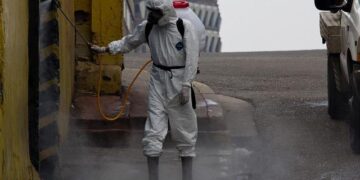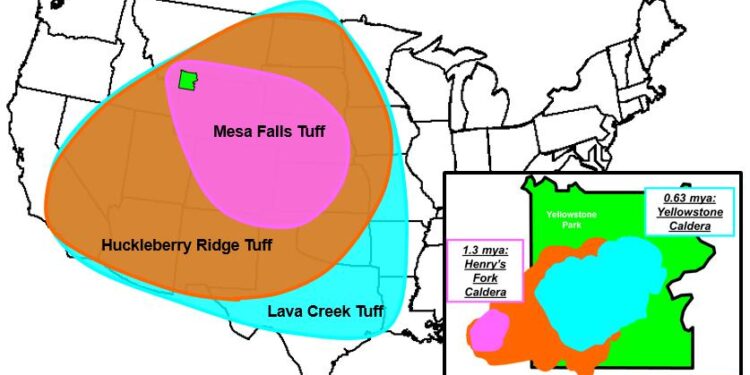Revolutionary Insights into Yellowstone’s Magma Reservoir
A remarkable advancement in geological research has emerged, significantly altering our comprehension of one of the Earth’s most renowned supervolcanoes. A dedicated team of geophysicists has accurately located a vast magma reservoir beneath Yellowstone National Park. This pivotal discovery, detailed in the latest issue of Physics World, utilizes cutting-edge imaging technologies to uncover the intricate underground formations that sustain the Yellowstone hotspot. As researchers delve deeper into potential volcanic activity in this area, this finding not only broadens our geological insights but also prompts critical discussions regarding the risks associated with this natural phenomenon. Given that the last major eruption took place over 640,000 years ago, these revelations have far-reaching implications for millions living nearby.
Uncovering Yellowstone’s Hidden Magma Reservoir
The recent study conducted by geophysicists has successfully identified an extensive magma reservoir beneath Yellowstone National Park, sparking renewed interest in its volcanic capabilities. By employing sophisticated imaging methods, scientists have revealed a more complex and expansive magma system than previously recognized. This breakthrough not only reshapes our understanding of Yellowstone’s geothermal features but also raises essential questions about potential volcanic activity and its environmental consequences.
Key findings from this research include:
- Magnitude and Configuration: The newly identified reservoir is considerably larger than earlier estimates indicated, extending several kilometers below ground.
- Magma Composition: The discovered magma is notably high in silica content, which may affect future eruption characteristics.
- Seismic Activity Correlation: Increased seismic events in the vicinity could be linked to changes within this reservoir, highlighting an urgent need for ongoing monitoring efforts.
| Main Findings | Potential Implications |
|---|---|
| Larger Magma Reservoir Identified | Heightened risk assessment for possible eruptions |
| Saturated with Silica | Increased likelihood of explosive eruptions |
Assessing Volcanic Hazards: Impact on Local Communities
The recent identification of a substantial magma reservoir at Yellowstone carries significant implications for understanding volcanic hazards within the region. Researchers estimate that this subterranean chamber may contain up to 30% more magma than previously thought—an increase that alters risk assessments related to potential eruptions and their effects on surrounding communities. Key considerations include:
- Eruption Likelihood Increase:A larger chamber heightens chances for volcanic unrest; thus improved monitoring systems are essential.
- Crisis Management Planning:Civic authorities must reassess current emergency protocols and evacuation routes to prepare adequately for any sudden volcanic events.
- Ecosystem Disruption Risks:The local environment could undergo severe transformations due to ash fallout and lava flows impacting agriculture and wildlife habitats.
This heightened potential for increased magmatic activity raises crucial questions about community resilience against such natural disasters. It is imperative that local governments invest in infrastructure enhancements as well as public awareness initiatives aimed at bolstering readiness should an eruption occur. Understanding regional geological factors can empower residents to better prepare themselves against unforeseen circumstances.
The following table outlines key hazards along with their possible impacts on communities:
| >Hazard<< / th >> << th >>Potential Effects<< / th >> << / tr >> << /thead>> < |
|---|
Enhancing Monitoring Strategies: Future Directions for Geophysical Research at Yellowstone
The recent discoveries concerning Yellowstones’ magma reservoir pave new pathways for geophysical exploration aimed at deepening our understanding of volcano systems worldwide.
To capitalize on these findings,researchers should consider implementing integrated monitoring frameworks combining various geophysical methodologies including:
- < li >< strong >< Seismic Networks:< strong >< br />Expanding sensor density across regions will enhance detection capabilities regarding subsurface movements.< li >< li >< strong >< GPS Technology:< strong >< br />Utilizing real-time GPS data will allow tracking ground deformation correlated with magmatic activities.< li >< li >< strong >< Remote Sensing:< strong />< br />Employ satellite imagery effectively monitor thermal changes across broader geographic areas.< li >
Additionally,< b style='font-weight:bold;'> fostering collaboration among multidisciplinary teams can greatly improve research efficacy by creating networks comprising volcanologists ,geologists ,and data scientists .This collaborative approach enables comprehensive analysis through shared datasets .A proposed framework might involve establishing centralized repositories where researchers can access contributions facilitating real-time evaluations .The table below illustrates anticipated outcomes from such collaborative efforts :< p />
| Collaboration Initiative | ||
|---|---|---|































